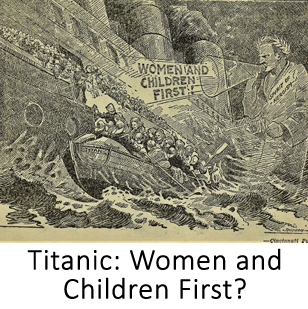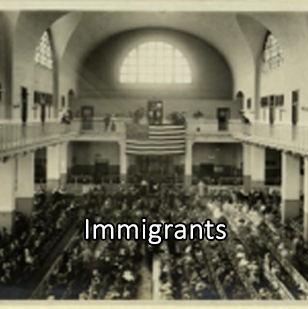The Chronicles
Click on a picture for more information (opens an Adobe PDF file).
Passengers
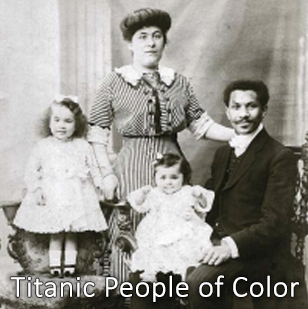 Joseph Laroche, born in Haiti, trained as an engineer in France. Unable to work in Europe because of his interracial marriage, he and his family were returning to Haiti. He perished but saved his family. Click here for Untold Stories of the Titanic: The Only Black Passenger....
Joseph Laroche, born in Haiti, trained as an engineer in France. Unable to work in Europe because of his interracial marriage, he and his family were returning to Haiti. He perished but saved his family. Click here for Untold Stories of the Titanic: The Only Black Passenger....
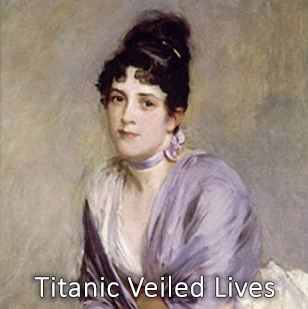 In the early 20th century, non-traditional relationships, although not openly recognized, were quietly accepted in the upper classes; prodding into the personal lives of brilliant and distinguished people was considered unseemly....
In the early 20th century, non-traditional relationships, although not openly recognized, were quietly accepted in the upper classes; prodding into the personal lives of brilliant and distinguished people was considered unseemly.... Violet Constance Jessop worked as a stewardess on all three White Star liners, Olympic, Titanic and Britannic. After Titanic’s collision, she was ordered into a lifeboat to look after passengers and a seemingly abandoned baby, whose mother was later found aboard the rescue ship Carpathia....
Violet Constance Jessop worked as a stewardess on all three White Star liners, Olympic, Titanic and Britannic. After Titanic’s collision, she was ordered into a lifeboat to look after passengers and a seemingly abandoned baby, whose mother was later found aboard the rescue ship Carpathia.... William Stead was an investigative journalist who worked for justice for women and children. President William Howard Taft invited him to speak at the International Conference on World Peace and International Arbitration on April 21, 1912. Stead accepted and boarded Titanic in Southampton….
William Stead was an investigative journalist who worked for justice for women and children. President William Howard Taft invited him to speak at the International Conference on World Peace and International Arbitration on April 21, 1912. Stead accepted and boarded Titanic in Southampton….
There are times when "survival of the fittest" is pushed aside by the deliberate choice to let others survive at the expense of one's own life. Such self-sacrificing behavior is the stuff of legend. However, history suggests that "women and children first" was not standard practice aboard ships at sea….
In 1904, the Danish steamer SS Norge left Copenhagen for New York City carrying over 700 passengers, including nearly 250 Russian Jews fleeing pogroms. When she went aground near Rockall, Scotland, the captain pried his ship free, only to have her flood. It was the worst death toll until Titanic, 8 years later....
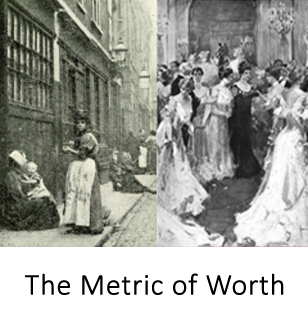 "Through the thin partition you can hear steerage passengers being sick, the varied accents as they converse, the crying of their children terrified by this new experience, or the clean flat smack of the parental hand in chastisement. To descend into steerage was an adventure that required some nerve. The stench was atrocious; each respiration tasted in the throat like some horrible kind of cheese"....
"Through the thin partition you can hear steerage passengers being sick, the varied accents as they converse, the crying of their children terrified by this new experience, or the clean flat smack of the parental hand in chastisement. To descend into steerage was an adventure that required some nerve. The stench was atrocious; each respiration tasted in the throat like some horrible kind of cheese"....
 "Washington Roebling planned a 2-month motor trip to tour Europe with his friend Stephen Blackwell, the 41-year-old son of a US Senator, and their chauffeur, Frank Stanley. Roebling met with the engineers at Fiat to discuss the finer points of design and drive the latest roadsters. Impressed, he purchased one to ship back to the United States. The three men planned to return with the automobile from Southampton, England, in early April 1912. Roebling and Blackwell boarded the new Titanic, but Stanley became ill and planned to return with the car when he recovered..."
"Washington Roebling planned a 2-month motor trip to tour Europe with his friend Stephen Blackwell, the 41-year-old son of a US Senator, and their chauffeur, Frank Stanley. Roebling met with the engineers at Fiat to discuss the finer points of design and drive the latest roadsters. Impressed, he purchased one to ship back to the United States. The three men planned to return with the automobile from Southampton, England, in early April 1912. Roebling and Blackwell boarded the new Titanic, but Stanley became ill and planned to return with the car when he recovered..."

Crew & Clergy
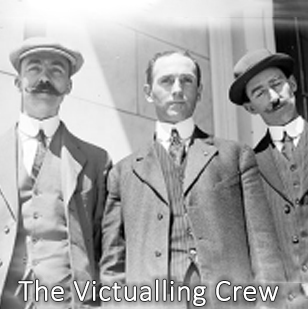 The needs of a transatlantic liner are similar to those of a small town--but one that is being steered and driven through the sea at over 25 miles per hour. Titanic's victualling crew of more than 500 stewards and stewardesses was the largest department aboard ship. It took care of the crew and all three classes of passengers....
The needs of a transatlantic liner are similar to those of a small town--but one that is being steered and driven through the sea at over 25 miles per hour. Titanic's victualling crew of more than 500 stewards and stewardesses was the largest department aboard ship. It took care of the crew and all three classes of passengers.... It took the skill and brawn of the men firing the boilers to keep coal-powered transatlantic liners on schedule. The ship's speed depended on the endurance of the men who made steam. Known as the "black gang," this group, working 4 hours on, 8 off, consisted of trimmers, coal passers, water tenders and firemen (or stokers)....
It took the skill and brawn of the men firing the boilers to keep coal-powered transatlantic liners on schedule. The ship's speed depended on the endurance of the men who made steam. Known as the "black gang," this group, working 4 hours on, 8 off, consisted of trimmers, coal passers, water tenders and firemen (or stokers)....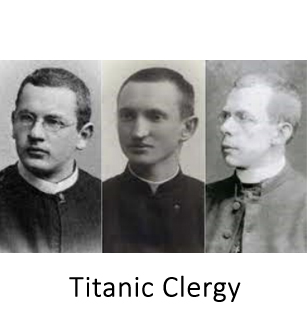 Some in religious quarters claimed that pride in a material object resulted in God teaching men how weak they really are. But the clergy on the ship, faced with the awful reality on board, courageously comforted and gave absolution to those at their time of death....
Some in religious quarters claimed that pride in a material object resulted in God teaching men how weak they really are. But the clergy on the ship, faced with the awful reality on board, courageously comforted and gave absolution to those at their time of death....
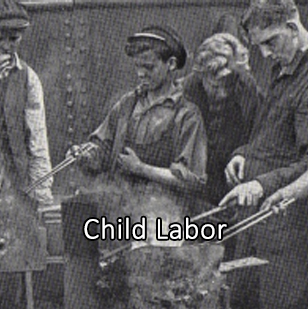 Harland & Wolff was one of two Belfast shipyards that employed boys, who worked on the hull as rivet catchers or "bellow boys," feeding air into the rivet forges. They worked from 6:00 am until 5:30 pm, 5 days a week plus a half day on Saturdays....
Harland & Wolff was one of two Belfast shipyards that employed boys, who worked on the hull as rivet catchers or "bellow boys," feeding air into the rivet forges. They worked from 6:00 am until 5:30 pm, 5 days a week plus a half day on Saturdays....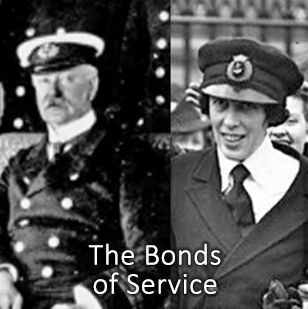 Those who worked on the ship... were given basic wages, food, housing, medical care and a ration of alcohol. This arrangement was originally just a verbal agreement, but by the 1800s, even illiterate seamen wanted some type of written contract. The popular image of adventure and romance belied the hardship and exploitation imposed on the average seaman....
Those who worked on the ship... were given basic wages, food, housing, medical care and a ration of alcohol. This arrangement was originally just a verbal agreement, but by the 1800s, even illiterate seamen wanted some type of written contract. The popular image of adventure and romance belied the hardship and exploitation imposed on the average seaman....
Officers
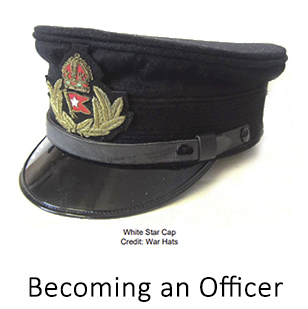 Young Britons seeking to become ship Masters in the British Merchant Marine first had to serve as indentured apprentices. To learn their profession, apprentices as young as 13 or 14 went to sea in deep-water sail—a dangerous environment....
Young Britons seeking to become ship Masters in the British Merchant Marine first had to serve as indentured apprentices. To learn their profession, apprentices as young as 13 or 14 went to sea in deep-water sail—a dangerous environment....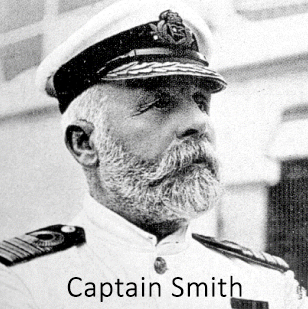 Edward J. Smith was born in 1850 in Staffordshire, England, to a working-class family that owned a pottery shop. Drawn to the sea, he left the steam forge that he'd joined after school to become an apprentice on the full-rigged ship Senator Weber....
Edward J. Smith was born in 1850 in Staffordshire, England, to a working-class family that owned a pottery shop. Drawn to the sea, he left the steam forge that he'd joined after school to become an apprentice on the full-rigged ship Senator Weber....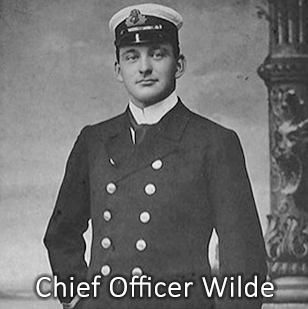 Henry T. Wilde was an officer in the Royal Naval Reserve in 1902, specializing in gunnery and torpedo tactics. He served on a number of warships and, widely considered an exemplary officer, he served as Second Officer on the liner RMS Cedric, the largest ship in the world in 1903....
Henry T. Wilde was an officer in the Royal Naval Reserve in 1902, specializing in gunnery and torpedo tactics. He served on a number of warships and, widely considered an exemplary officer, he served as Second Officer on the liner RMS Cedric, the largest ship in the world in 1903....
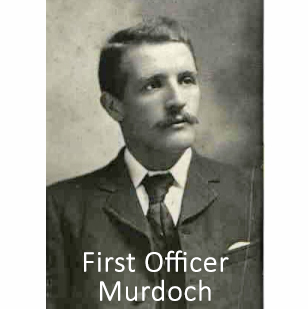 William M. Murdoch's sea-faring grandfather, James Murdoch, was swept off his ship by one wave and deposited back on board by the next. He lived until 1900, but the sea took the lives of two sons and two grandsons, including William on April 15, 1912, aboard Titanic....
William M. Murdoch's sea-faring grandfather, James Murdoch, was swept off his ship by one wave and deposited back on board by the next. He lived until 1900, but the sea took the lives of two sons and two grandsons, including William on April 15, 1912, aboard Titanic....
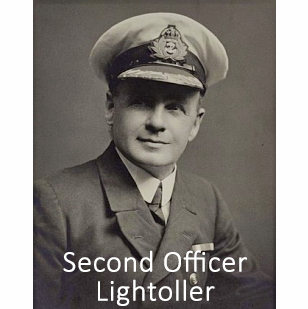 When Charles H. Lightoller turned 14, he signed aboard the big, three skysail yarder Primrose Hill. As a young apprentice, he was given the highest and lightest sails to set and furl. His first trip introduced him to the difficulties of handling a big square rigger....
When Charles H. Lightoller turned 14, he signed aboard the big, three skysail yarder Primrose Hill. As a young apprentice, he was given the highest and lightest sails to set and furl. His first trip introduced him to the difficulties of handling a big square rigger....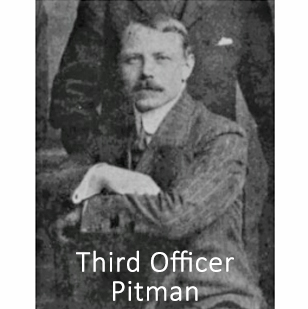 As Third Officer aboard Titanic, Herbert J. Pitman’s duties included helping supervise the deck crew and the quartermasters and relieving senior watch officers. Like other officers, he also was responsible for determining Titanic’s position during his watch....
As Third Officer aboard Titanic, Herbert J. Pitman’s duties included helping supervise the deck crew and the quartermasters and relieving senior watch officers. Like other officers, he also was responsible for determining Titanic’s position during his watch....
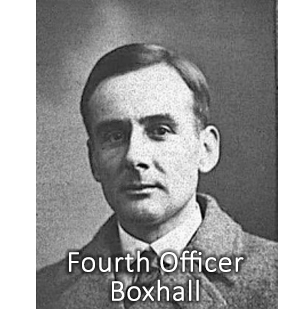 The wireless operators needed an accurate position to send a distress call. Joseph G. Boxhall calculated Titanic’s location by dead reckoning, estimating the distance traveled using the stellar position taken earlier that evening and the time multiplied by the ship’s speed....
The wireless operators needed an accurate position to send a distress call. Joseph G. Boxhall calculated Titanic’s location by dead reckoning, estimating the distance traveled using the stellar position taken earlier that evening and the time multiplied by the ship’s speed....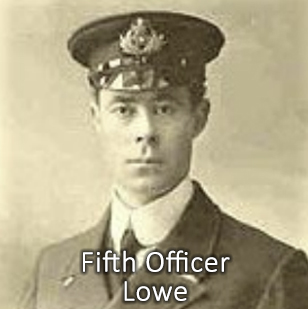 Harold G. Lowe ran away from home at about age 14, when his father tried to apprentice him to a business man. Saying, “I wouldn’t work for nobody for nothing,” he went to sea aboard coastwise sailing vessels as an ordinary seaman....
Harold G. Lowe ran away from home at about age 14, when his father tried to apprentice him to a business man. Saying, “I wouldn’t work for nobody for nothing,” he went to sea aboard coastwise sailing vessels as an ordinary seaman....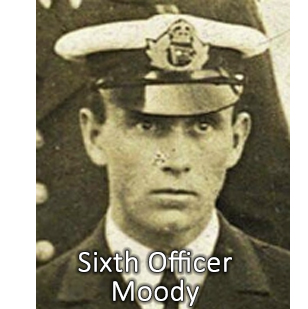 Early in his career, James P. Moody wrote, "Lots of people have put in their letters how they would love to be seeing all the beautiful places I am seeing, but I tell them to stop at home or else invent a floating palace which doesn't roll and can't possibly sink."
Early in his career, James P. Moody wrote, "Lots of people have put in their letters how they would love to be seeing all the beautiful places I am seeing, but I tell them to stop at home or else invent a floating palace which doesn't roll and can't possibly sink." 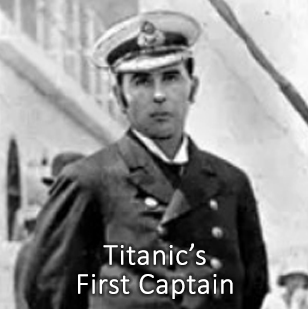 In the early hours of Monday, April 15, 1912, Captain Herbert Haddock, commanding the White Star liner Olympic, was exchanging messages with Captain Arthur Rostron of Cunard's Carpathia regarding the fate of Titanic and her survivors. Haddock had commanded both Olympic and Titanic and was 500 miles west by south of Titanic when she called for help. Olympic altered course and increased speed in an attempt to reach her....
In the early hours of Monday, April 15, 1912, Captain Herbert Haddock, commanding the White Star liner Olympic, was exchanging messages with Captain Arthur Rostron of Cunard's Carpathia regarding the fate of Titanic and her survivors. Haddock had commanded both Olympic and Titanic and was 500 miles west by south of Titanic when she called for help. Olympic altered course and increased speed in an attempt to reach her....

Building the Titanic
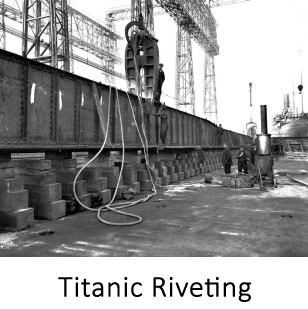 When a ship, making her way through heavy seas, is supported by waves at bow and stern, the hull sags midships. When the wave is midships, the bow and stern sag. As ships became larger, stresses are amplified, making good riveting paramount....
When a ship, making her way through heavy seas, is supported by waves at bow and stern, the hull sags midships. When the wave is midships, the bow and stern sag. As ships became larger, stresses are amplified, making good riveting paramount....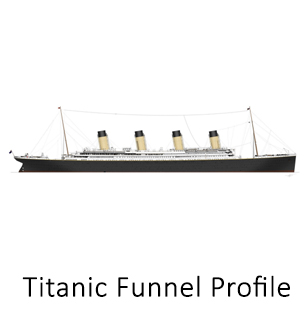 A subtle characteristic of RMS Titanic and her sisters is that the two middle funnels were about a foot taller than the two end funnels. This was to compensate for the sheer of the hull and avert an uneven profile when the ship was viewed broadside....
A subtle characteristic of RMS Titanic and her sisters is that the two middle funnels were about a foot taller than the two end funnels. This was to compensate for the sheer of the hull and avert an uneven profile when the ship was viewed broadside.... 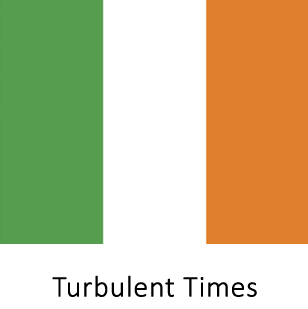 The Titanic was built in Belfast, Ireland. Most of the 20,000 workers were Protestant, with only about 300 Catholics, who were generally in menial positions. After the disaster, Protestants claimed credit for building Titanic, while blaming Catholics for the tragedy, while Catholics considered Titanic a wholly Protestant debacle....
The Titanic was built in Belfast, Ireland. Most of the 20,000 workers were Protestant, with only about 300 Catholics, who were generally in menial positions. After the disaster, Protestants claimed credit for building Titanic, while blaming Catholics for the tragedy, while Catholics considered Titanic a wholly Protestant debacle....
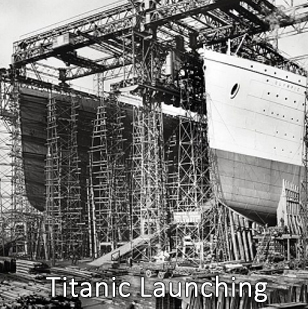 At the time of launch, the hull is structurally complete but empty. It must be as light as possible, yet be strong enough to withstand the stresses imposed on it by its first trip into the water. Only after the ship is safely waterborne can workers begin to install the machinery, accommodations and other systems....
At the time of launch, the hull is structurally complete but empty. It must be as light as possible, yet be strong enough to withstand the stresses imposed on it by its first trip into the water. Only after the ship is safely waterborne can workers begin to install the machinery, accommodations and other systems.... Harland & Wolff of Belfast employed about 15,000 workers with 3,000 engaged in building Titanic. Eight exceptional employees were chosen to tend to the ship on her maiden voyage. Known as the Guarantee Group, they were headed by Thomas Andrews, one of the principle naval architects responsible for designing Titanic....
Harland & Wolff of Belfast employed about 15,000 workers with 3,000 engaged in building Titanic. Eight exceptional employees were chosen to tend to the ship on her maiden voyage. Known as the Guarantee Group, they were headed by Thomas Andrews, one of the principle naval architects responsible for designing Titanic.... 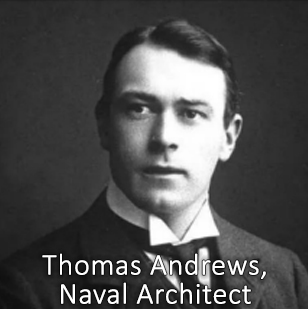
Unpretentious and socially progressive, Thomas Andrews's even temper and friendly personality drew respect from all who met him. He dedicated his final moments to save as many as he could from his doomed ship.
Technical Matters
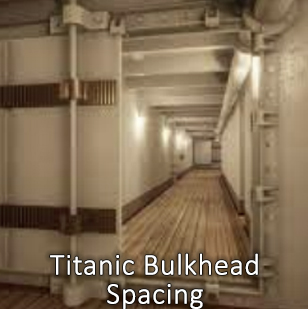 “The captain can, by simply moving an electric switch, instantly close the doors throughout and make the vessel practically unsinkable.” The midsummer issue of the 1911 British publication, The Shipbuilder, was dedicated to the new White Star superliners Olympic and Titanic....
“The captain can, by simply moving an electric switch, instantly close the doors throughout and make the vessel practically unsinkable.” The midsummer issue of the 1911 British publication, The Shipbuilder, was dedicated to the new White Star superliners Olympic and Titanic....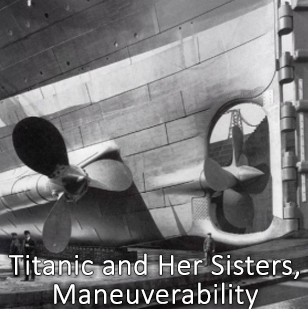 One of the inquiries after the accident addressed was how quickly Titanic needed to turn to avoid the iceberg. Their hurried investigation determined that Titanic had insufficient rudder area and inadequate maneuverability to avoid the collision....
One of the inquiries after the accident addressed was how quickly Titanic needed to turn to avoid the iceberg. Their hurried investigation determined that Titanic had insufficient rudder area and inadequate maneuverability to avoid the collision.... 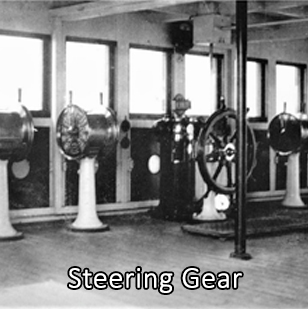 Keeping a vessel’s compass course is a point of pride for the mariner. Whether handling the tiller
Keeping a vessel’s compass course is a point of pride for the mariner. Whether handling the tillerof a racing sloop, the wheel or joystick of a tug and tow, cruise or container ship, keeping the
proper heading takes skill and concentration. A powered vessel that holds her course saves time,
fuel and keeps her schedule. ....
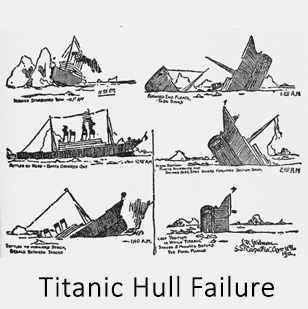 It wasn’t until Titanic was discovered in 1986 by a Woods Hole Oceanographic Institute expedition, led by Robert Ballard, that it became known for certain that the ship experienced a total structural failure and broke in two....
It wasn’t until Titanic was discovered in 1986 by a Woods Hole Oceanographic Institute expedition, led by Robert Ballard, that it became known for certain that the ship experienced a total structural failure and broke in two....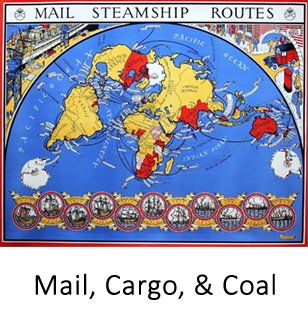 Although transatlantic liners were primarily passenger vessels, companies sought the valuable and profitable designation of Royal Mail Steamer (RMS). From the 1850s, various lines were contracted by the British Government to carry mail throughout the world. Among the shipping lines engaged in the mail service were White Star, Cunard, Union Castle Line, and Orient Line....
Although transatlantic liners were primarily passenger vessels, companies sought the valuable and profitable designation of Royal Mail Steamer (RMS). From the 1850s, various lines were contracted by the British Government to carry mail throughout the world. Among the shipping lines engaged in the mail service were White Star, Cunard, Union Castle Line, and Orient Line....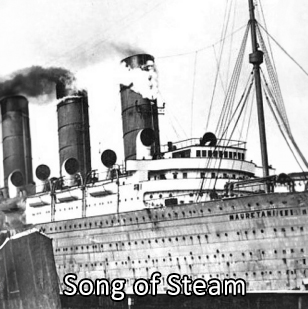 Carefully controlled steam pressure is key for maintaining desired engine revolutions. Too much or too little steam pressure wastes fuel, boiler feed water and risks damaging the equipment. To get a ship across the ocean, the boilers must continuously produce great volumes of steam to fill the cylinders to push the pistons, turn the paddles or propeller, and keep the ship moving.
Carefully controlled steam pressure is key for maintaining desired engine revolutions. Too much or too little steam pressure wastes fuel, boiler feed water and risks damaging the equipment. To get a ship across the ocean, the boilers must continuously produce great volumes of steam to fill the cylinders to push the pistons, turn the paddles or propeller, and keep the ship moving.
Aftermath
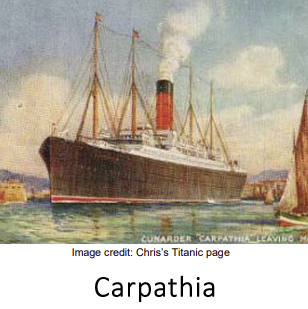 The Carpathia avoided six large icebergs and never slowed. She lunged ahead at 17 knots, shuddering with the effort, faster than she would ever go again. At 4 am, they reached the spot. A dazzling and empty sea lay before the captain, where Titanic should have been....
The Carpathia avoided six large icebergs and never slowed. She lunged ahead at 17 knots, shuddering with the effort, faster than she would ever go again. At 4 am, they reached the spot. A dazzling and empty sea lay before the captain, where Titanic should have been....
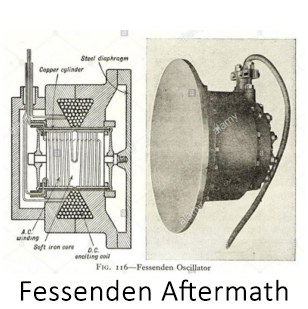 The loss of RMS Titanic sparked numerous ideas and inventions to make ship travel safer. They included detachable sections of deck that could be launched and serve as floating rafts, a string of large buoys chained across the Atlantic so ships in distress could tie up to them....
The loss of RMS Titanic sparked numerous ideas and inventions to make ship travel safer. They included detachable sections of deck that could be launched and serve as floating rafts, a string of large buoys chained across the Atlantic so ships in distress could tie up to them....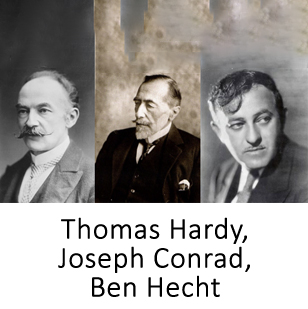 Practically from the time the sea closed over RMS Titanic, the disaster was the source of countless articles, books, plays and films. Three famous writers addressed the tragedy in poetry and essays: Thomas Hardy, Joseph Conrad, and Ben Hecht....
Practically from the time the sea closed over RMS Titanic, the disaster was the source of countless articles, books, plays and films. Three famous writers addressed the tragedy in poetry and essays: Thomas Hardy, Joseph Conrad, and Ben Hecht....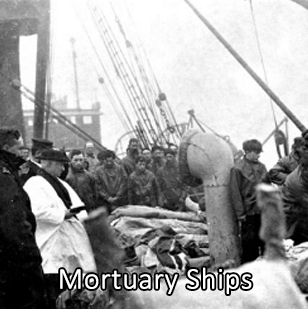 Not long after Titanic sank, steamships plying the same waters reported passing furniture, chairs, lifejackets and bodies. Passengers on SS Bremen were horrified by the gruesome scene of men, women and children bobbing lifelessly in the sea, many the victims of hypothermia. Four small ships were dispatched to recover the dead….
Not long after Titanic sank, steamships plying the same waters reported passing furniture, chairs, lifejackets and bodies. Passengers on SS Bremen were horrified by the gruesome scene of men, women and children bobbing lifelessly in the sea, many the victims of hypothermia. Four small ships were dispatched to recover the dead….
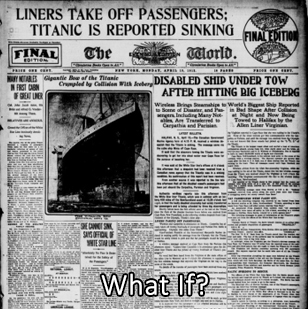 History's revisionist hope is that Californian would have arrived in time to save all on board Titanic. As difficult as this would have been, professional, well-disciplined seamen, with timing and luck, might have been able to pull it off, had one or two situations been different....
History's revisionist hope is that Californian would have arrived in time to save all on board Titanic. As difficult as this would have been, professional, well-disciplined seamen, with timing and luck, might have been able to pull it off, had one or two situations been different.... 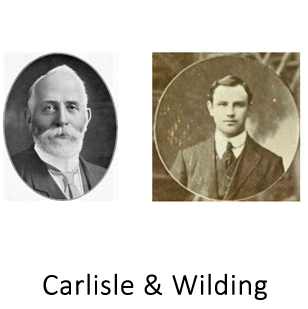 "The perfect naval architect is an individual who is erudite in all aspects of ship design and construction; able to build, launch and put a ship into service; predict how fast she will go and how she will behave at sea; and determine what she will carry, earn and cost to operate. Most important of all, the ship will do exactly what the naval architect says she'll do." Titanic's designer Andrews worked with Alexander
Carlisle and Edward H. Wilding, both of whom played key roles in the ship's design and construction and, being intimate with the ship's design details, testified at the post-disaster British Inquiry.
"The perfect naval architect is an individual who is erudite in all aspects of ship design and construction; able to build, launch and put a ship into service; predict how fast she will go and how she will behave at sea; and determine what she will carry, earn and cost to operate. Most important of all, the ship will do exactly what the naval architect says she'll do." Titanic's designer Andrews worked with Alexander
Carlisle and Edward H. Wilding, both of whom played key roles in the ship's design and construction and, being intimate with the ship's design details, testified at the post-disaster British Inquiry.